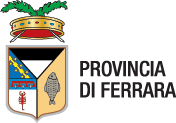Art and culture
Casa Minerbi - Dal Sale
A jewel of Ferrara’s historical heritage, the recently restored Casa Minerbi – Dal Sale is an architectural complex which stands because of the fascinating dialogue between ancient and modern, immediately perceptible in the internal areas where fourteenth century pictorial cycles can be admired connected to contemporary spatiality created between 1957 and 1963 by architect Piero Bottoni from Milan.
Casa Romei
Giovanni Romei became administrator to the lords of Ferrara and married the princess Polissena d’Este. On the Via di San Francesco he had a house built that showed his high ranking.
Cathedral
THE INTERIOR IS CLOSED FOR RENOVATION WORKS. NEXT OPENING, MARCH, 23rd 2024 - The cathedral of Ferrara dates from the 12th century and bears witness to all the historical periods of the city. The outstanding façade, divided into three sections, was begun in Romanesque style, still visible in the lower part
Cathedral Museum
The Cathedral Museum, sited in the ex church of San Romano, was created through a join initiative between the Cathedral Chapter and the Municipality of Ferrara with the aim of documenting the history of the most important sacred temple of Este spirituality
Charterhouse
The Charterhouse, built by Borso d’Este in 1461, was transformed into a monumental cemetery at the beginning of the 1800s and conserves important sculptures.
Church of Gesu'
Built for the Jesuits in 1570 to the design ofthe architect Alberto Schiatti, the church has a simple and austere brick façade, divided into two sections and with three portals decorated with marble.
Church of San Francesco
The church, erected in 1594 on a pre-existing Franciscan complex, the church is a masterpiece of the architect Biagio Rossetti.
Church of San Giorgio
The presence of the church, dedicated to the patron saint of the city, is documented as long ago as the 10th century.
Church of Santa Maria in Vado
Of ancient origins, the church was built near a ford (vado in Italian) that crossed one of the many canals that intersected the area.
Corso Ercole I d'Este
It was called Via degli Angeli after the church of St. Mary of the Angels that once rose at the end of it.
Corso Giovecca
This street, built by Biagio Rossetti by demolishing the old walls, forms the link between the Medioeval city to the south, and the Addizione Erculea to the north,...
Estense Castle
In Ferrara in 1385, a dangerous revolt convinced Niccolò II d’Este of the need to erect mighty defences for himself and his family thus the Castello di San Michele was built, a fortress erected against the people
Ferrara, town of the Renaissance and its Po Delta
UNESCO, the United Nations Education, Scientific and Cultural Organisation, included the territory around Ferrara in its lists on two separate occasions.
Giovanni Boldini Museum
TEMPORARILY CLOSED. Re-opening after restoration. The Boldini Museum is dedicated to the Ferrarese painter who lived between 1842 and 1931.
House of Ludovico Ariosto
The house, probably built to the design of Girolamo da Carpi, has a simple but elegant brick façade
Jewish Ghetto
In the heart of the medieval city lies the ghetto, an area which conserves the memories of the centuries-old Jewish Community of Ferrara and where the same community was from 1627 to 1861.
Lapidary Museum
The Lapidary Museum, housed in the ex-church of Santa Libera, has a rich collection of Roman works in marble from the province of Ferrara
MEIS Museo Nazionale dell'Ebraismo Italiano e della Shoah
At the National Museum of Italian Judaism and the Shoah are open the permanent exhibitions: "1938: HUMANITY DENIED" by Giovanni Grasso and Paco Lanciano and "Jews, an Italian history" to discover the history of Jews in Italy from the era of ancient Rome to the Renaissance.
Modern and Contemporary Art Gallery
The Modern and Contemporary Art Gallery houses important, prestigious temporary exhibitions organised in collaboration with Ferrara Arte,...
Monastery of Corpus Domini
It keeps the memories of Santa Caterina Vegri together with some tombs of the Este family: among them, the tomb of Lucrezia Borgia
Monastery of Sant'Antonio in Polesine
Set in the heart of the medieval city, the monastery still gives the sense of isolation and tranquillity it did during its early years, when it stood upon an island in the middle of the Po.
Museo del Risorgimento e della Resistenza
The Museum is closed to the public until further notice.
Museo dell'Ottocento
TEMPORARILY CLOSED. Re-opening after restoration. The Museum of the Ottocento begins with three rooms chiefly dedicated to religious subjects (Giovanni Pagliarini Madonna and Child) and historical ones (Gaetano Turchi Torquato Tasso in Sant’Anna).
Museum of Casa Romei
Giovanni Romei became administrator to the lords of Ferrara and married the princess Polissena d’Este. On the Via di San Francesco he had a house built that showed his high ranking
Museum of Modern and Contemporary Art 'Filippo De Pisis'
TEMPORARILY CLOSED. Re-opening after restoration. Exposition begins with two works by Mario Sironi: Justice and Mural Composition.
Museum of Natural History
The Museum will reopen to the public from 4th October 2022
Museum of Palazzo Schifanoia
Extraordinary vestige of the splendour of the Renaissance period, Palazzo Schifanoia is the symbol of Este Ferrara. New itinerary is open to visitors (divided over 1400 square meters, 21 rooms, about 250 works of art), new layout, new lights and new museographic concept, developed with the aim of reconnecting Ferrara with one of the most important testimonies of its history
Museum of rural life
The Museum of rural life was created through the cooperation of Mr. Guido Scaramagli and the Municipality of Ferrara
National Archaeological Museum
The museum, housed in the Palazzo Costabili, exhibits the findings of the Etruscan city of Spina which flourished from the 6th to the 3rd century B.C. and survived until the first centuries A.D.






